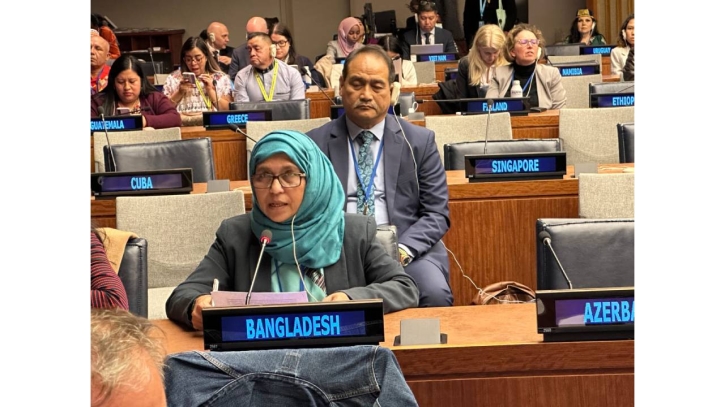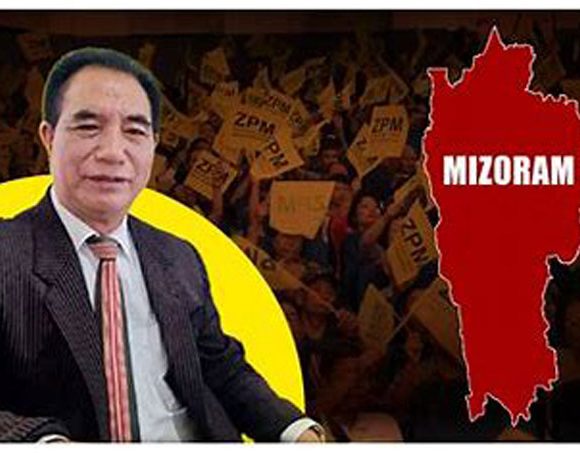Why does UN acknowledge Bangladesh efforts to implement CHT Peace Accord finally?

The United Nations Permanent Forum on Indigenous Issues has acknowledged the progress made in implementing the Chittagong Hill Tracts (CHT) Peace Accord, in its report on its 22nd session, held in New York from April 17 to 28. The Bangladesh delegation spoke about the achievements of the government in the implementation of the agreement during various meetings of the forum.
CHT has a history of a bloody conflict between its Bengali settlers and indigenous communities. After the assassination of the Father of the Nation Bangabandhu Sheikh Mujibur Rahman in 1975, the state deployed military force to maintain law and order in CHT which led to further escalation of conflicts between law enforcers and indigenous communities who have been living there since time immemorial.
However, to introduce peace and end bloody conflicts in the three hill districts, Prime Minister Sheikh Hasina signed the CHT Peace Accord in 1997. As a part of the accord, the people of CHT witnessed the withdrawal of 250 army camps from the region. Also, some 1,800 rebels surrendered their arms to her on February 10 in 1998 at Khagrachhari Stadium. It needs no emphasizing that the insurgents did it as the government of Sheikh Hasina could earn their confidence in the government. It was indeed a glaring example of resolving disputes peacefully. Such an instance of arms surrender is rare in human history.
Some 48 out of the total 72 clauses of the CHT Peace Treaty have already been implemented while 15 others partially implemented and the remaining nine clauses are under implementation process.
Before the peace accord the ownership of the land in the CHT were determined by the British-era laws according to which people of indigenous communities were not able get land ownership.
But after the accord, people of CHT enjoy the ownership of the land just as the people of other regions in the country do.
Earlier, life in the hilly region was difficult due to lack of economic opportunities in absence of development activities. But the incumbent government over the years has changed the scenario. Now the people of the hill districts, especially in remote areas, are reaping the benefits of improved infrastructure as many locals are now running hotels and restaurant businesses in their areas. Over the last ten years, the people of CHT have gone through a lot of development initiatives taken by the government. Road and transportation scene of CHT has drastically changed and consequently lifestyle of hill people has improved in the last decade or so.
Some 48 out of the total 72 clauses of the CHT Peace Treaty have already been implemented while 15 others partially implemented and the remaining nine clauses are under implementation process.
We hope that Sheikh Hasina’s government will do everything to fully implement all the sections of the peace accord as her government was the first to take noble initiatives for the welfare of the indigenous communities.
To put an end to the brutal confrontations between the government troops and the tribes and hillsmen of the Chittagong Hill Tracts, the Chittagong Hill Tracts Peace Accord was signed 25 years ago. Following the agreement, it was thought that if it were put into practice, the economy would pick up. This hope has come true over the past 25 years. The locals’ way of life has changed. The government’s numerous development initiatives have improved the economic situation for millions of people in the region.
Before the deal, visitors were hesitant to visit the hilly areas. As the security situation has improved, tourists are now visiting the mountains without hesitation. Trade and commerce used to move slowly because of the inadequate communication infrastructure, but now it moves much more quickly. The wheel of everyday existence had been closed for two decades prior to then. In the modern regional and international arena, the successful political resolution of the CHT conflict is considered a remarkable achievement for our country.
The 1997 Bangladesh government made an effort to create enduring peace in the hill areas. After that, in 1997, there was an armistice that ultimately came to be known as the Chittagong Hill Tracts Agreement or the Peace Accord. The majority of the agreement’s provisions, according to the administration, have allegedly been carried out. Additionally, the unrealized clauses will be promptly implemented, therefore a favorable climate is required.
On the other side, a number of schools and colleges, including Rangamati University of Science and Technology and Rangamati Medical College, have been established in the 20 years after the peace deal. The field of communication has seen advancement.
The majority of the jhum crops would have been lost along the route in the past, but since road connectivity has improved there, hill farmers now can simply sell their jhum crops at the market.
The lumber industry has seen the largest improvement since the accord. Since the deal, the region’s timber trade has expanded. Despite not previously purchasing hillside tree gardens, traders are now doing so. The gardeners reap financial rewards.
All of the Chittagong Hill Tracts districts, including Rangamati, have experienced general economic development as a result of improvements in every area, including education, communication, and security. A native of Rangamati named Laxmidhan Chakma remarked, “Government jobs used to seem like golden deer to us.” The educated and deserving children of the Hill Tracts are now, however, easily obtaining government jobs as a result of the Hill Tracts Peace Accord. Without the agreement, it was never feasible.
The wheel of the mountain economy continued to turn after the peace deal notwithstanding a few episodes focusing on rivalry and hegemony among the regional parties.
Due to many actions the government took after the peace deal, economic prosperity has been attained in a similar manner to how people’s living standards have increased. Analyzing the periods prior to and following the peace accord can help us comprehend this.
The Hill People were allowed to trade easily following the Hill Tracts Peace Accord. The blockage of some regional groups frightened the general population. However, the residents of the hills are now exhaling in relief as a result of the ceasefire deal. With the administration’s unparalleled collaboration, the locals operate independently. Before the Hill Accords, trade and business in the hill country were at a standstill. The typical person was unable to move freely. But that time is passed. People can conduct business freely today. Trade and commerce have benefited from the expansion in communication. The police administration is set up so that everyone in this place can carry out their responsibilities on their own.
Ten additional development projects have been started in the meantime to further develop the Chittagong Hill Tracts. The Planning Commission has received a proposal from the Ministry of Chittagong Hill Tracts for inclusion in the Green Leaf in the upcoming 2021–22 Fiscal Year’s Annual Development Program (ADP). The allocation has been requested concurrently for 19 active projects.
The Chittagong Hill Tracts Development Board’s Rural Road Development Project in Rangamati Hill District will last till 2021–2024. In the Rangamati Hill District, the construction period for rural infrastructure has been set at 2024.
The improvement of the water system in Bandarban Municipality and Lama Municipality of Bandarban Hill District is planned to include the construction of a master drain by 2023. Additionally, a deadline of 2023 has been set for the development of the different rural roads built by the Board in the Bandarban Hill District.
It has been determined that construction of a bridge and connecting road from Upazila Sadar to isolated regions of the Khagrachhari district will begin in 2025 with the goal of assisting the socioeconomic development of the Chittagong Hill Tracts’ underprivileged residents. The completion date for the road project connecting Khagrachhari district’s Laxichhari Upazila Sadar and Barmachhari Bazar is 2025. Building rural road infrastructure in the Khagrachhari Hill District is being done in an effort to connect isolated villages in various Upazilas to the Upazila Sadar communication network.
Construction is underway on a rural road that would connect Ruma Upazila in the Bandarban Hill District to Roangchhari Upazila Sadar. In the isolated Chittagong Hill Tracts, a high-value spice farming initiative is being conducted.
A master drain for the development of the drainage system of the Khagrachhari district headquarters and the elimination of water blockage are also being built, along with two bridges over the Sangu river and one over the Sonakhali canal in Bandarban Hill District.
Additionally, there is an increase in cotton farming in the Chittagong Hill Tracts region and a reduction in farmer poverty, as well as development in all Upazilas, including Rangamati municipality, and power supply via the installation of solar panels in remote Chittagong Hill Tracts areas (Phase II). Construction of irrigation drains in various Upazilas of the Bandarban Hill District, irrigation drains in various Upazilas of the Khagrachhari district of the Chittagong Hill Tracts, and the provision of potable drinking water via GFS and deep Tube Well in all areas in rocky areas in various Upazilas of the Bandarban district are all included in this project.
Other programs to reduce poverty include growing cashew and coffee in the CHT region, as well as managing water supply and sanitation in the Khagrachari district’s marketplaces and surrounding neighborhoods. establishing and executing the network, which at the moment serves as the main access point for the residents of the three hill districts of Rangamati, Bandarban, and Khagrachari to get essential social services.
The Chittagong Hill Tracts Peace Accord recognized the hill people’s unique status and dignity. A regional council made up of the local government councils of the three hill districts has been established in accordance with the peace deal.
The Regional Council is organized as follows: Chairman 1, Native American Member 12, Native American Woman 2, Native (Non-Indigenous) Male 6, Non-Indigenous Member, Female 1. The accord asks for the creation of a Ministry of Tribal Affairs, headed by one tribe, to regulate operations concerning the Chittagong Hill Tracts. Their land will be returned if the tribes’ land ownership rights are established. In order to ascertain who owns the property, a land survey system will be implemented in the Chittagong Hill Tracts.
Every home of the tribal people is now filled with educated young people. The literacy rate of Chakmas is 96 percent on average, with at least one employee per household.
The development of tribal people in the Chittagong Hill Tracts is significantly better than that of any outlying area of Bangladesh due to the implementation of quota systems in all jobs, including BCS, priority systems, and quotas for tribal students in all medical schools and universities as well as scholarships in Europe, America, and Australia.
The current prime minister, Sheikh Hasina, is always working to meet the expectations of the residents of the Chittagong Hill Tracts. In the highland areas, the current administration has not implemented any anti-people, anti-democracy measures. The Chittagong Hill Tracts Development Board’s chairperson was chosen when the Awami League administration took office.
The Minority Cultural Institutions Bill 2010 and the creation of the Land Commission have been approved by the National Assembly. In the interim, everyone has come to terms with the idea that tribes, minorities, ethnic groups, and communities can safeguard the nation’s integrity. We believe that in order for there to be development, Sheikh Hasina’s efforts to bring about peace must be supported.
The successful execution of numerous ongoing socio-economic development initiatives provides compelling evidence of the need for the Hill Tracts Peace Agreement to be put into effect. The conviction to uphold the rights of all citizens as stated in the peace agreement must be put into action, but the hill-Bengalis must work together to do so.


















